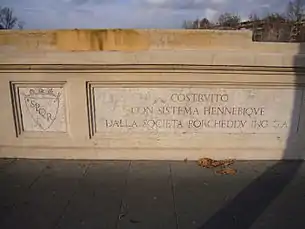41°55′07″N 12°28′14″E / 41.918725°N 12.470609°E
Ponte del Risorgimento | |
|---|---|
 Ponte del Risorgimento, Rome | |
| Coordinates | 41°55′07″N 12°28′14″E / 41.91861°N 12.47056°E |
| Crosses | River Tiber |
| Locale | Rome, Flaminio and Della Vittoria Quarters, Italy |
| Characteristics | |
| Material | Reinforced concrete |
| Total length | 159.10 m (522.0 ft) |
| Width | 20.95 m (68.7 ft) |
| Longest span | 100.00 m (328.1 ft) |
| History | |
| Designer | Giovanni Antonio Porcheddu |
| Construction start | 1909 |
| Construction end | 1911 |
| Opened | April 17, 1911 |
| Location | |


Ponte del Risorgimento (or briefly Ponte Risorgimento) is a bridge that links Piazzale delle Belle Arti to Piazza Monte Grappa in Rome (Italy), in the Flaminio and Della Vittoria quarters.[1]
History and description
The bridge links the area of Lungotevere delle Armi to Piazzale delle Belle Arti.[2]
The works for the building began in 1909 and were completed two years later. The bridge was designed and built by Giovanni Antonio Porcheddu,[3] with the cooperation of the engineers Giaj and Parvopassu, on the occasion of the exhibition for celebrating the 50th anniversary of Italian unification. It is the first bridge in Rome made in reinforced concrete, since its creator, at that time, was the only Italian dealer of the patent of the Belgian François Hennebique.
The day of the inauguration (April 17, 1911), the spectators doubted that the structure, after the removal of the supporting scaffoldings, wouldn't have stood up; on the contrary, Porcheddu was so sure about the effectiveness and reliability of the new technique that he wanted to attend the demolition of the scaffolding on a little boat just below the arch of the bridge, together with his two youngest kids, Giuseppe and Ambrogia.[4] During the ceremony, King Victor Emmanuel III offered Porcheddu the epithet "King of reinforced concrete".[3]
In the middle of the bridge, on both bulwarks, are two inscriptions:
on one side, and
on the other.[5]
Notes
- ↑ Ravaglioli, p. 52.
- ↑ Rendina, p. 953.
- 1 2 Antonio Dore (June 22, 2005). "Il Lingotto di Torino ha un'anima ittirese". La Nuova Sardegna. p. 22. Retrieved August 2, 2011.
- ↑ Vanni Lòriga, cit., Sassari, 2003
- ↑ Noir – Notiziario dell'Ordine degli Ingegneri della Provincia di Roma, p. 486
Bibliography
- Ravaglioli, Armando. Roma anno 2750 ab Urbe condita. Storia, monumenti, personaggi, prospettive (1997 ed.). Tascabili Economici Newton, Rome. ISBN 88-8183-670-X.
- Rendina, Claudio. Enciclopedia di Roma (2005 ed.). Newton Compton Editori, Rome. ISBN 88-541-0304-7.
- Dolara, Ezio. Enciclopedia di Roma (2005 ed.). Newton Compton Editori, Rome. ISBN 88-541-0304-7.
- Ezio Dolara (2011). "Il Ponte del Risorgimento a Roma. Storia, cronaca, genialità, intuizione". Noir – Notiziario dell'Ordine degli Ingegneri della Provincia di Roma (486): 22–29.